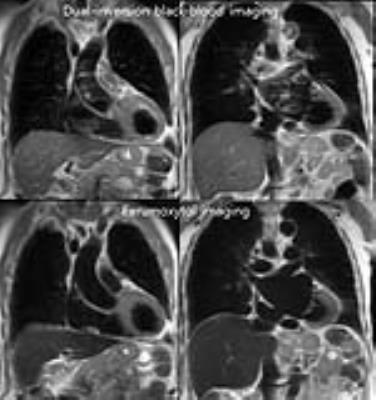3278
Post-Contrast Black-blood HASTE: Initial Results with Ferumoxytol1Diagnostic Cardiovascular Imaging Laboratory, David Geffen School of Medicine at UCLA, Los Angeles, CA, United States, 2Department of Radiological Sciences, David Geffen School of Medicine at UCLA, 3Division of Cardiology, David Geffen School of Medicine at UCLA and VA Greater Los Angeles Healthcare System
Synopsis
Black blood imaging is helpful in cardiovascular evaluation, but is challenging due to its dependence on through-plane blood flow. We explored ferumoxytol-enhanced black-blood Half-Fourier Acquisition Single-shot Turbo Spin-echo (HASTE) imaging for cardiovascular morphologic evaluation and compared its effectiveness with pre-contrast double inversion (DIR) HASTE. Post-ferumoxytol HASTE showed complete and homogeneous blood suppression and better qualitative image scores (all, p<0.001) for all cardiovascular regions. The technique holds promise for confident definition of thrombus or plaque, independently of blood flow.
PURPOSE
Black blood imaging is valuable for detailed characterization of cardiovascular morphology. Researchers have recently explored the off-label use of ferumoxytol for cardiovascular bright-blood imaging due to its potent longitudinal r1 relaxtivity (1, 2). However, the more general use of ferumoxytol (FE) as a black blood cardiovascular imaging agent due to strong transverse r2 relaxivity has been minimally explored (3), and to our knowledge single shot black blood imaging with ferumoxytol has not previously been described. We aimed to assess the reliability of ferumoxytol enhanced HASTE imaging without magnetization preparation pulses for morphologic evaluation of blood vessels and cardiac chambers and to compare its effectiveness with DIR imaging.METHODS
After written informed consent, 285 unique patients underwent FE-MRI for various clinical indications at our institution, pre-contrast DIR HASTE was performed in 119 patients and post-ferumoxytol HASTE without DIR pulses was performed in 184 patients. Quantitative measurements including homogeneity index (defined as standard deviation of the left atrial signal intensity) and signal-to-noise ratio (SNRs) for cardiac chambers and great vessels in the thorax were compared. Qualitative image quality scores reflecting complete suppression of blood signal were also evaluated using a 3-point scale by two readers: 3, perfect; 2, adequate and; 1, non-diagnostic. Results were compared using the Wilcoxon-signed rank test.RESULTS
Of the 285 unique patients who underwent ferumoxytol MRI, 119 patients had pre-contrast conventional black-blood HASTE imaging and 184 had post-FE HASTE without DIR. Eighty-six patients had both pre and post-FE HASTE (ages 3 days to 90 years). Compared to conventional DIR black-blood images, FE black-blood images showed significantly lower mean values of homogeneity indices (156.0±89.9 vs. 27.5±10.8, p <0.001) and lower SNRs for all cardiovascular regions (overall, 28.4±41.9 vs. 7.1±6.3, p <0.001) (Figure 1), indicating more effective blood signal suppression in cardiac chambers and vascular lumens. Cardiac and vascular borders are well-defined with minimal to no intra-luminal flow artifacts. Qualitative image scores were significantly better in ferumoxytol images (overall, 1.8±0.6 vs. 2.9±0.2, p <0.001, Figure 2). FE HASTE provided consistent and effective black-blood imaging irrespective of age (Figure 1).CONCLUSION
Black-blood HASTE imaging using ferumoxytol provided safe and effective blood suppression quantitatively and qualitatively, independently of blood flow. The technique holds promise for rapid black blood imaging and for more reliable definition of intraluminal thrombus and plaque.Acknowledgements
No acknowledgement found.References
1. Prince MR, Zhang HL, Chabra SG, Jacobs P, Wang Y. A pilot investigation of new superparamagnetic iron oxide (ferumoxytol) as a contrast agent for cardiovascular MRI. Journal of X-ray science and technology 2003;11(4):231-240.
2. Li W, Tutton S, Vu AT, et al. First-pass contrast-enhanced magnetic resonance angiography in humans using ferumoxytol, a novel ultrasmall superparamagnetic iron oxide (USPIO)-based blood pool agent. J Magn Reson Imaging 2005;21(1):46-52.
3. Vu AT, Li W, Pierchala L, Tutton S, Prasad P, Edelman R. Robust and Efficient Whole Heart Black Blood Cine Imaging. Proc. Intl. Soc. Mag. Reson. Med. 13 (2005)

